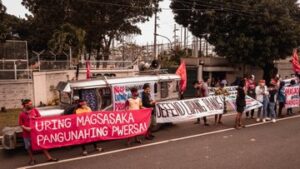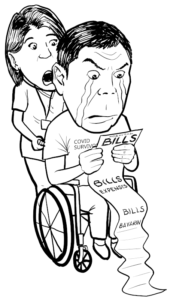Social media in the Philippines: Channel of unity and struggle


Because of the Covid-19 pandemic and the militarist lockdown, physical assemblies and mobilizations of democratic organizations in the Philippines were limited in 2020. (Read related article in Ang Bayan December 21, 2020.) In this light, various sectoral mass organizations in urban centers strove to use online platforms to arouse, organize, mobilize and study.
Based on initial data collated by Ang Bayan, there have been more than 300 online activities last year, mostly by local chapters of mass organizations. These includes online protests, cultural concerts, social media rallies, webinars and political discussions, orientations at chapter building, and meetings. The youth is the most active sector in online activism.
A number of fora and protests were organized by national centers of democratic organizations (there were weekly activities, and others were build-up online activities for upcoming mobilizations).
The biggest online protest was held on May 1, 2020 and spearheaded by Kilusang Mayo Uno in commemoration of the International Labor Day. It was viewed 77,000 times in Facebook. Individuals also simultaneously posted photos to assert the people’s right to health and livelihood.
The most popular forms of online actions this year were online fora and short discussions on the enactment of the Anti-Terror Law (ATL). A number of fora and discussions were launched by local chapters of youth organizations in Metro Manila, Southern Tagalog, Cordillera and several provinces in Visayas and Mindanao.
Social media also served as a venue to gather tens of thousands of signatures against the ATL and to demand the renewal of ABS-CBN’s franchise. The call #JunkTerrorLaw also trended several times to oppose the said law, simultaneous with #OustDuterteNow.
Calls against red-tagging also resounded over the internet, as well demands by health and government workers for hazard pay and free mass testing, criticism of of the online learning system using the #NoStudentLeftBehind, and support for jeepney drivers using the #BalikPasada to demand the resumption of jeepney operations.
The potential of social media in in mobilizing support when the country was hit by successive typhoons late last year. Calls for donations, and aid spread quickly, as well as the demand to hold the Duterte regime accountable for its inaction using the #NasaanAng Pangulo (Where is the President?) which trended in November 2020.
Various community and factory-based organizations actively posted their grievances in social media during the lockdown. They criticized the regime for the slow release of funds for its Social Amelioration Program as well as inadequate food aid.
Clusters of workers, urban poor residents and villagefolk also launched online consultations to identify the grievances of the people. This is on top of invididual posts by the poor masses, youth and professionals.
The reactionary state met the advance in online protests with repression. Many were harassed and arrested for posting their grievances and criticisms online.
Huge potential of social media
A study in October 2020 indicates that around 81 million Filipinos are internet-users. Filipinos spend the longest hours in the internet compred to other countries in the world, with an average usage of 10 hours per day. They spend four hours in social media. Majority of them are aged 20 to 34 years old.
Facebook is accessed by nearly all of the 81 million Filipino internet-users. More than 40 million are reached by Youtube, 14 million by Instragram, 10 million by Snapchat, and 7.8 million by Twitter.










